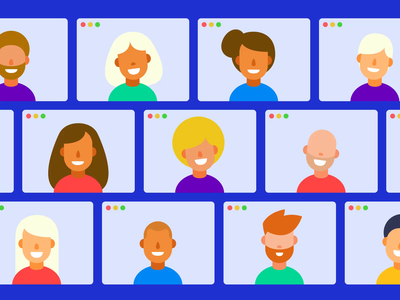As a fully remote team, we’ve learned that a crucial part of our success lies in making communication and transparency a deliberate process, rather than a passive one. Over the years, we’ve found that one of the best ways to put that value into practice is through our weekly all-hands town hall.
Every Tuesday morning, our all-hands team meeting is focused on showcasing what each team is tackling that week—whether they’re working on a big product launch, or smaller feature improvements. This meeting usually lasts about an hour, and always has an agenda in the form of a deck that lives in Google Drive. It’s also an opportunity for us to get some valuable “face to face” time together, acknowledge people that have gone above and beyond for us that week, and share personal stories.
Here are some of our best pieces of advice for those looking to make their town halls more meaningful!
1. Find a cadence that works for your team
Our teams are most effective when everyone understands where and how their individual work fits in the overall context of helping us make progress towards our mission. The best way for someone on our team to make a decision about what’s good for Dribbble is to have all of the information about what’s going on across the entire company. To that end, it’s important that we’re all up to date about what’s happening, even within areas of the company that we’re not actively involved with on a daily basis.
Since we’re fully distributed and organic opportunities to connect as a team around these topics are more limited, we’ve chosen to hold our town-halls on a weekly basis, rather than a monthly, quarterly, or annual one. This cadence ensures we’re all clear on what’s going on across the company on any given week.
2. Put people first
We’re a backwards-mullet kind of place—party in the front, business in the back! We like to kick off our team calls on a fun, personal note. We start by recognizing birthdays, work anniversaries, and other major life milestones. There’s usually some great gifs involved, too. We also feature folks that go above and beyond at our weekly team call through shoutouts that are written and read by different members of the team. Every now and then, we pull in a celebrity from Cameo to mix things up as well!
Starting our calls off this way has been a great way to set the tone for our time together. It also helps demonstrate how individual contributions impact our team, product, and company as a whole, and ensures we’re fostering a culture of recognition, appreciation, and feedback.
3. Make it a team effort
Part of the magic of our all-hands is that it’s a team effort. Every project update is given by someone who is actually taking part in that project, so they can speak directly to their experience with it. Not only is this a learning opportunity for the audience, but it’s also a chance to practice public speaking and presentation skills for the presenters. These are extremely valuable skills to have on any team, but particularly on remote ones, so our all-hands doubles as a weekly outlet to hone this skillset. Having multiple speakers makes it a much more engaging experience for those listening in.
4. Be prepared
Is there anything worse than staring at slide after slide of text? We don’t want people to zone out when an update isn’t about their function, so we use visual demos, rather than mere bullet points. Having people showcase their work in real-time—rather than just seeing images or text on the screen—makes it much more relevant and engaging for the rest of the team.
One of the best ways to ensure everyone gets value out of the meeting is having a slide deck with visuals that compliment everyone’s presentation topics. Additionally, everyone presenting is expected to prepare their slides well in advance. We spend time on Friday and Monday making sure the slides are all polished up and ready to go on Tuesday morning, and many hands make light work!
5. Go beyond the status update
During our calls, each functional team gives a visual update on their work in progress to ensure we’re highlighting the connections and dependencies between team members’ work. But it doesn’t stop at a simple status update—we tie these presentations back to broader themes around our vision and mission. Rather than simply sharing dense charts and numbers, we spend time explaining our metrics, results, and contextual information to make the data actionable and useful for good decision making.
6. Keep the video on
Since our face-to-face time is limited, our team keeps their video cameras on, so we can see everyone’s faces in Zoom. This makes our town-hall experience a much more personal one, helping to foster a sense of connection among our team. It’s also a nice way to help those presenting on the call feel like they have an engaged audience!
7. Provide conversation prompts
We reserve time at the end of each town hall for free-flowing conversation and personal stories. However, as our team started to grow with more new faces being added to the Zoom grid, we realized we needed to try something other than just the open-mic format. There’s nothing worse than sitting in a Zoom meeting with everyone on mute, waiting for someone to say something!
To help get the conversation flowing again, we introduced weekly conversation prompts to help focus the conversation around a specific idea or topic. We share it at the beginning of the call, to give the team time to think about what they might want to share, and then we open the floor up for dialogue and discussion at the end of the call.
Facilitating conversation through prompts this way has been a huge help, and has resulted in a lot of really interesting conversations and learning more about one another. The key to getting interesting answers is asking interesting questions—some of our favorite conversation prompts include:
- What’s the best advice you’ve ever been given?
- What’s the best gift you’ve ever received?
- How do you like to wind down after work in the evening?
- What does your morning routine look like?
- Who do you admire the most?
- What gadget do you own that everyone should know about?
- What’s one fact about you that others may not know?

Final thoughts
We firmly believe that it’s important to protect everyone’s calendars, and avoid meetings for meetings’ sake. The last thing we want is to have our team walk away from a call feeling like it should have been an email.
Centering our town-halls around these practices has so far been one of the best ways to help equip our team with the information they need to make good decisions for the company, and to hold themselves and their teammates accountable. By inclusively sharing knowledge with the entire team on a regular basis, every single person on the team is kept on the same page about what we’re building, and how their contributions play a meaningful role in furthering us towards our mission.
While we’re all for reducing the number of meetings on the calendar, we believe that an impactful town hall is one of the best ways to reinforce your team’s culture and communication. Working remotely shouldn’t have to mean sacrificing a sense of cohesion, community, and connection; regular town halls with purposeful agendas are one of the best steps that can be taken to avoid the slippery slope of feeling disconnected from one another and experiencing information silos. Properly executed, town halls can lay the foundation for strong organizational communication, relationships, strategy, and decision making.
RELATED READING
- 9 commandments of building a strong remote team culture
- A designer’s advice for transitioning into a remote job
- Top 5 challenges of working remotely & how to overcome them
Find more Community stories on our blog Courtside. Have a suggestion? Contact stories@dribbble.com.











